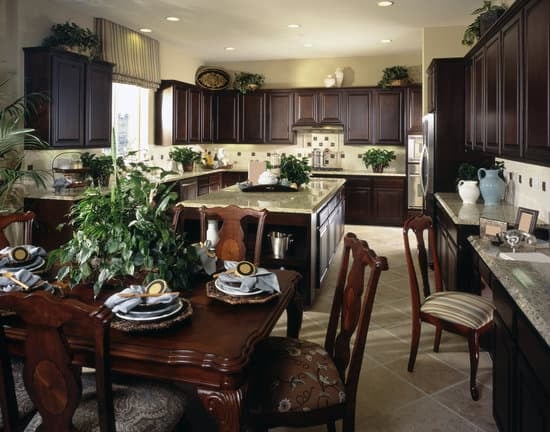The 1930s marked a tumultuous period in American history, characterized by the lingering effects of the Great Depression and the dawn of technological advancements. In the midst of economic hardship, home decor reflected both a desire for escapism and a response to the practical challenges of daily life. This article will explore the predominant decorating style in 1930s homes, shedding light on its characteristics and lasting influence on modern design.
During the 1930s, the Great Depression had a profound impact on every aspect of American life, including interior design. The prevailing economic climate influenced home decor choices, leading to a shift in aesthetic preferences and functional considerations. Despite these challenges, this era saw the rise of distinct design styles that continue to inspire contemporary interiors.
One dominant decorating style that emerged during this period was Art Deco. Known for its bold geometric shapes, sleek lines, and vibrant colors, Art Deco epitomized the glamour and modernity sought after by homeowners in the 1930s. However, alongside Art Deco’s popularity, other design influences also played significant roles in shaping 1930s home decor. This exploration aims to provide insight into these diverse influences and their enduring legacy on modern design trends.
Art Deco
In 1930s home decor, Art Deco was characterized by a focus on angular and symmetrical shapes, as well as the use of materials such as stainless steel, lacquer, and inlaid wood. Furniture featured streamlined profiles and glossy finishes, reflecting the sleek and luxurious nature of the style. Additionally, bold colors such as deep blues, rich greens, and vibrant reds were often used to add drama and visual interest to interiors.
Notable examples of well-known Art Deco homes from the 1930s include the Chrysler Building in New York City and the Hoover Building in London. These iconic structures exemplify the prominent role that Art Deco played in shaping not only interior design but also architecture during this era.
| Characteristic | Description |
|---|---|
| Geometric Shapes | Symmetrical and angular patterns used in furniture and decor |
| Bold Colors | Deep blues, rich greens, vibrant reds for dramatic effect |
| Luxurious Materials | Stainless steel, lacquer, inlaid wood for sleek finishes |
The Role of Technology and Innovation
The 1930s marked a period of significant technological advancements, and these innovations played a crucial role in shaping home decor during that time. As the Great Depression gripped the nation, people were increasingly seeking solace and comfort within their homes. This led to an integration of modern conveniences and new materials into interior design, reflecting the desire for practicality and efficiency.
One major influence on 1930s home decor was the rise of mass production, which allowed for greater accessibility to well-designed furnishings and decor items. The availability of affordable, innovative products transformed the way people decorated their homes. For example, streamlined furniture with clean lines and minimal ornamentation became popular due to its affordability and modern aesthetic.
Technological advancements also introduced new materials into home decor in the 1930s. For instance, homeowners embraced the use of plastics such as bakelite for decorative objects and electrical appliances. These materials not only provided a sleek modern look but also contributed to the overall functionality of everyday items within the home.
Advancements in technology also influenced architectural design during this period, leading to more efficient use of space within homes. Architects and designers incorporated modern construction techniques that allowed for open floor plans and improved natural lighting, reflecting a shift towards a more functional yet aesthetically pleasing living environment.
| Technological Advancements | Impact on Home Decor |
|---|---|
| Mass production | Accessibility to well-designed furnishings |
| New materials (e.g. plastics like bakelite) | Modern look and functionality in decor items |
| Architectural design innovations | Efficient use of space and improved natural lighting |
Streamlined Moderne and Bauhaus Influences
In the 1930s, home decor was greatly influenced by the Streamlined Moderne and Bauhaus design principles. These styles were a departure from the ornate and decorative Art Deco movement that dominated the era. Instead, Streamlined Moderne and Bauhaus design focused on clean lines, minimalism, and functionalism. Here are some key points about these influential design movements:
1. Clean Lines: Streamlined Moderne and Bauhaus design prioritized simple, straight lines and smooth curves in furniture and architecture. This minimalist approach contrasted with the more elaborate and ornate Art Deco style.
2. Functionalism: Both Streamlined Moderne and Bauhaus placed a strong emphasis on functionality in design. Furniture was designed to be practical and efficient, often incorporating storage solutions and multi-purpose features.
3. Influence on Architecture: The influence of Streamlined Moderne and Bauhaus design extended beyond interior decor to architecture as well. Many homes built during this time reflected the clean lines and geometric shapes associated with these styles.
Influential Examples: Notable homes from the 1930s that exemplified Streamlined Moderne and Bauhaus influences include the Villa Savoye by Le Corbusier, a famous example of International Style architecture, as well as various residential designs by renowned architect Mies van der Rohe.
Overall, the influence of Streamlined Moderne and Bauhaus design on 1930s home decor marked a significant shift towards modernism in interior design. This departure from traditional ornamentation laid the groundwork for contemporary minimalist aesthetics that continue to be popular in modern home decor today.
The Rise of Pastel and Neutral Color Palettes
The 1930s saw a significant shift in color palettes for home decor, moving away from the bold and vibrant hues of the Art Deco era to softer, more muted tones. Influenced by Hollywood and the emerging cinema culture, pastel and neutral colors began to gain popularity in interior design. The economic climate of the Great Depression also played a role in this shift, as homeowners sought comfort and tranquility in their living spaces.
Influence of Hollywood
The glamorous world of Hollywood had a major impact on the color choices for 1930s home decor. As movies became more popular and accessible, people began to admire the stylish settings seen on screen. Soft pastels and neutral tones were often used to create elegant and sophisticated environments in films, inspiring homeowners to replicate this aesthetic in their own living spaces.
Popular Color Choices
Pastel shades such as powder blue, blush pink, mint green, and buttery yellow became popular choices for walls, furniture, and accessories during the 1930s. These colors evoked a sense of serenity and calmness, providing a peaceful retreat from the challenges of daily life during the Great Depression. Neutral tones like beige, taupe, and ivory were also embraced for their versatility and ability to create a timeless look.
Impact on Interior Design
The rise of pastel and neutral color palettes in 1930s home decor reflected a desire for simplicity and escapism during tumultuous times. These soothing hues created a sense of warmth and comfort within interiors while also blending seamlessly with other design elements such as streamlined furniture and minimalist patterns. The legacy of these color trends continues to influence modern interior design, with many homeowners still drawn to the serene elegance of pastels and neutrals in their homes today.
Functional and Practical Furnishings
The 1930s were a time of economic struggle and practicality, and this was reflected in the home decor of the era. Functional and practical furnishings were highly valued during this time, as people sought to make the most of what they had while also prioritizing efficiency and utility in their homes. Here are some key aspects of the functional and practical furnishings that were prevalent in 1930s home decor:
1. Practicality over Ornamentation:
During the 1930s, there was a shift away from ornate and elaborate furniture towards more streamlined and simple designs. The focus was on functionality and space-saving solutions, with multi-purpose furniture becoming increasingly popular. Pieces such as sofa beds, drop-leaf tables, and built-in storage units became common as people looked for ways to maximize their living spaces.
2. Emphasis on Durability:
Due to the economic hardship of the Great Depression, durability became a key factor in furniture choices. People wanted pieces that would last a long time and withstand daily use without needing frequent replacement. As a result, materials like steel, chrome, and plywood gained popularity for their strength and resilience.
3. Influence of the ‘Make Do and Mend’ Mentality:
The frugality of the 1930s led to a trend of repurposing and repairing existing furniture rather than buying new items. This mentality was reflected in home decor as well, with homeowners finding creative ways to update their interiors without spending much money. It was common for people to reupholster old chairs, refinish wooden pieces, or repurpose household items for different uses.
Overall, the focus on practicality in 1930s home furnishings continues to influence modern design trends. The emphasis on versatility, durability, and making the most of limited space remains relevant today as people seek functional yet stylish solutions for their homes.
The Role of Textiles and Patterns
The use of textiles and patterns played a significant role in shaping the interior design of 1930s homes. During this time, fabric choices and patterns were influenced by both the economic climate and the prevailing design aesthetic. The use of textiles, such as curtains, upholstery, and linens, added an extra layer of warmth and comfort to homes while also serving as a means of self-expression.
Popular Fabric Choices and Patterns
In the 1930s, popular fabric choices for home decor included durable materials such as wool, linen, and cotton. These fabrics were not only practical but also reflected the emphasis on functionality and durability that was characteristic of the era. When it came to patterns, geometric designs, stripes, and floral motifs were commonly used in upholstery and curtains. These patterns added visual interest to interiors while still maintaining a sense of sophistication.
How the Economic Climate Influenced Fabric Choices
The economic constraints of the Great Depression also had a significant impact on fabric choices for home decor. With financial resources limited for many households, there was a greater focus on cost-effective options that still provided quality and longevity. As a result, practicality became key when selecting fabrics for furnishings, with an emphasis on durability and longevity rather than trendy or extravagant designs.
Design Trends
The economic climate also influenced design trends in textiles during the 1930s. There was a shift towards simpler and more understated patterns and color palettes in response to the challenging times. The use of muted tones such as pastels or neutral colors became more prevalent in fabric choices as they provided a sense of tranquility and calmness within the home. This subdued approach to textiles reflected the need for comfort and reassurance during a tumultuous period in history.
The influence of 1930s textile choices and patterns can still be seen today in contemporary interior design. Many modern designers continue to draw inspiration from the functional yet stylish approach to textiles from this era, integrating them into current decor trends. The legacy of 1930s textile choices serves as a testament to their enduring appeal and timeless relevance in shaping interior design aesthetics across generations.
Legacy and Influence on Modern Design
In conclusion, the 1930s was a decade marked by significant historical events such as the Great Depression, which had a profound impact on home decor. Art Deco emerged as the dominant style of the era, characterized by geometric shapes, sleek lines, and bold colors. This style reflected the desire for glamour and escapism in the face of economic hardship, making it a defining feature of 1930s home design.
Advancements in technology also played a crucial role in shaping 1930s home decor, leading to the integration of modern conveniences and new materials into interior design. Streamlined Moderne and Bauhaus influences further contributed to the clean, minimalist aesthetic that characterized many homes of this era. Additionally, Hollywood and cinema influenced color trends, resulting in a shift towards pastel and neutral color palettes that exuded elegance and sophistication.
The emphasis on practicality and functionality in furnishings, as well as the use of textiles and patterns influenced by the economic climate, were also pivotal aspects of 1930s home decor. Despite its historical context, the legacy of 1930s design continues to influence modern interior design.
Many designers and architects draw inspiration from the styles of this period, integrating its principles into contemporary homes and decor trends. Overall, 1930s home decor has left a lasting impact on modern design, showcasing how historical influences continue to shape our living spaces today.
Frequently Asked Questions
What Was the Style of Interior Design in the 1930s?
The style of interior design in the 1930s was characterized by a mix of modern and traditional elements. It featured streamlined, geometric shapes, bold patterns, and a focus on functionality and simplicity.
What Was the Style of the House in the 1930s?
The style of houses in the 1930s often reflected the Art Deco movement, with curved lines, geometric patterns, and sleek surfaces. Bungalows, Tudor-style homes, and Colonial Revival houses were also popular during this time.
What Design Period Is the 1930s?
The design period of the 1930s is considered part of the Art Deco movement, which emerged during the interwar period. This design style is known for its sleek, geometric forms, bold colors, and use of materials like chrome and glass to create a sense of modern luxury.

I’m thrilled to be your companion on this exciting journey through the world of home decor and design. With a passion for turning houses into homes and a keen eye for the finer details, I’m here to help you transform your living spaces into beautiful, functional, and meaningful havens.





